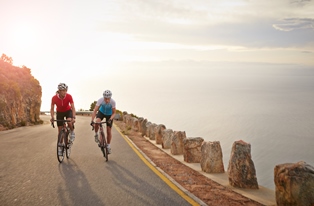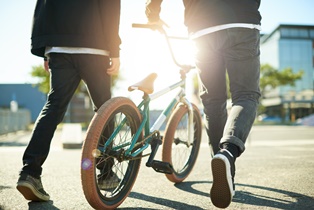Safety tips for cyclists

Many South Africans cycle every day as a form of transport, for recreation and as a sport. Cycling is fun, cheap, and a great way to keep fit. It can be enjoyed by people of all ages and is an effective way to beat the traffic.
Cycling is an accessible form of travel for many people and for many it's a primary source of transport. It is important that both cyclists and motorists take their safety and the safety of other road users seriously.
Safety tips for cyclists
Cyclists have the same responsibilities as motorists to make sure that everyone that uses our roads are safe. SafelyHome compiled a list of safety precautions to follow when you go cycling:
- Make use of pedal cycle lanes where these are available.
- Keep as close as possible to the left edge of the roadway.
- Obey the traffic signs and signals.
- Ride with traffic, not against it.
- Watch out for the opening of car doors in your path.
- Be visible. Wear bright coloured clothing at daytime. At night, wear reflective clothing.
- Fit and use effective front and rear lights when riding in hours of darkness and when visibility is limited.
- Use hand signals when turning or changing lanes.
- Be aware of hazardous road conditions.
- Be aware of other road users, especially at intersections.
- Ride in a straight line.
- Wear a helmet that fits properly.
- Never ride with headphones.
Laws for cyclists
There are laws, both national and provincial, in place to protect the rights of all road users, including cyclists. These laws apply to everyone using our roads and they cover various aspects to make sure that you and your fellow road users are safe at all times.
The National Traffic Act 93 of 1996 and the National Road Traffic Regulations is the national legislation and applies to everyone in South Africa. These laws cover the following important rules that all cyclists should adhere to, including:
- Always stop at red traffic lights and stop signs.
- Give way to pedestrians and stop before pedestrian crossings.
- All cyclists must ride with the flow of traffic on streets, whether it’s a two-way or a one-way street.
- Cycling without a helmet is illegal.
- Always ride on the left of the road.
- You must be seated in your saddle when cycling.
- You must ride in single file.
- You may not deliberately swerve your bicycle from side to side.
- You must use the bicycle lane if there is one.
- You may not cycle on freeways (like the M3, M5, N1 and N2) and all other roads which indicate they are off limits to bicycles.
 The other important legislation that cyclists should follow is the Western Cape Provincial Road Traffic Administration Act, 2012. This legislation applies to motorists and cyclists in the Western Cape. The key points under the provincial legislation are:
The other important legislation that cyclists should follow is the Western Cape Provincial Road Traffic Administration Act, 2012. This legislation applies to motorists and cyclists in the Western Cape. The key points under the provincial legislation are:
- Motorists must leave a distance of at least 1 meter between them and cyclists.
- Cyclist must ride in a single file unless overtaking.
- Cyclists riding at night must have lights fitted on the front and back of their bicycle.
- Bicycles must have front and rear reflectors.
Motorists should also respect the rights of cyclists using the roads. As a motorist it is important to take the following safety precautions to make certain of the safety of cyclists on the road:
- Yield to cyclists, especially at intersections.
- Leave a distance between the motor vehicle and the cyclist of at least one metre.
- Check your blind spots and look before opening the car door.
- Don't drive, stop or park in a bicycle lane.


